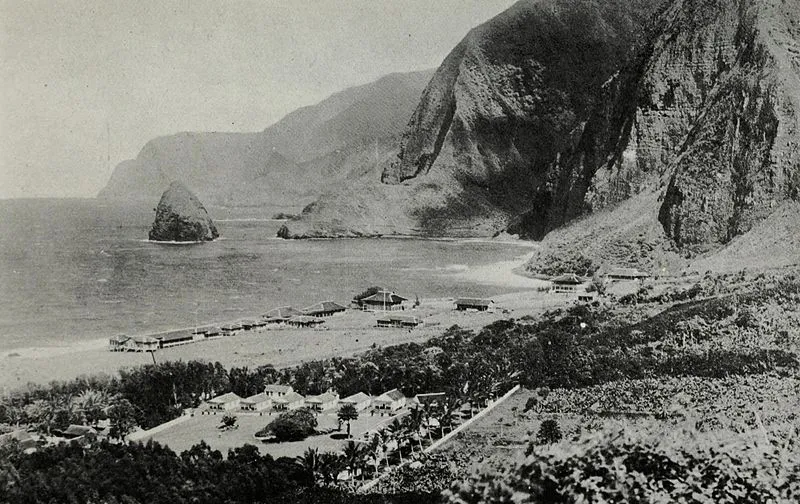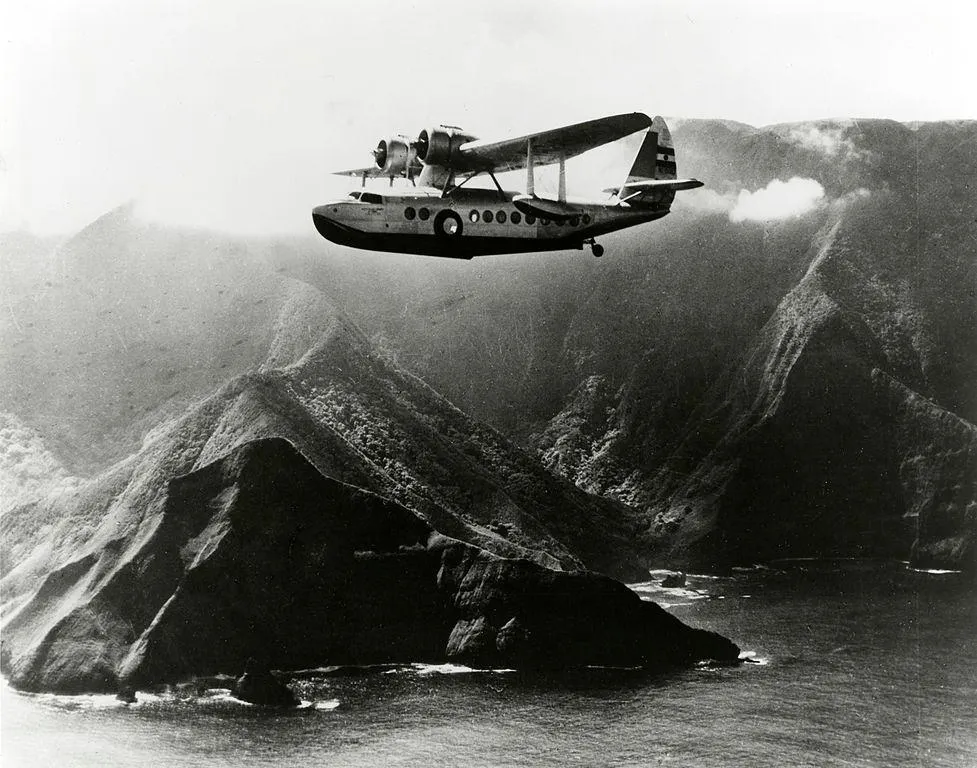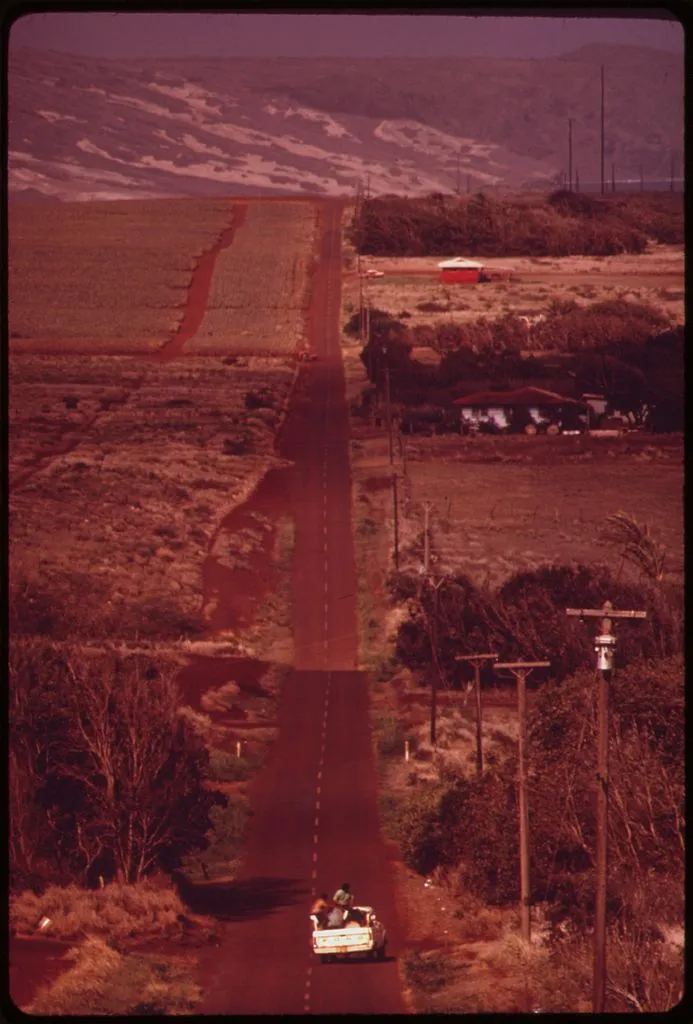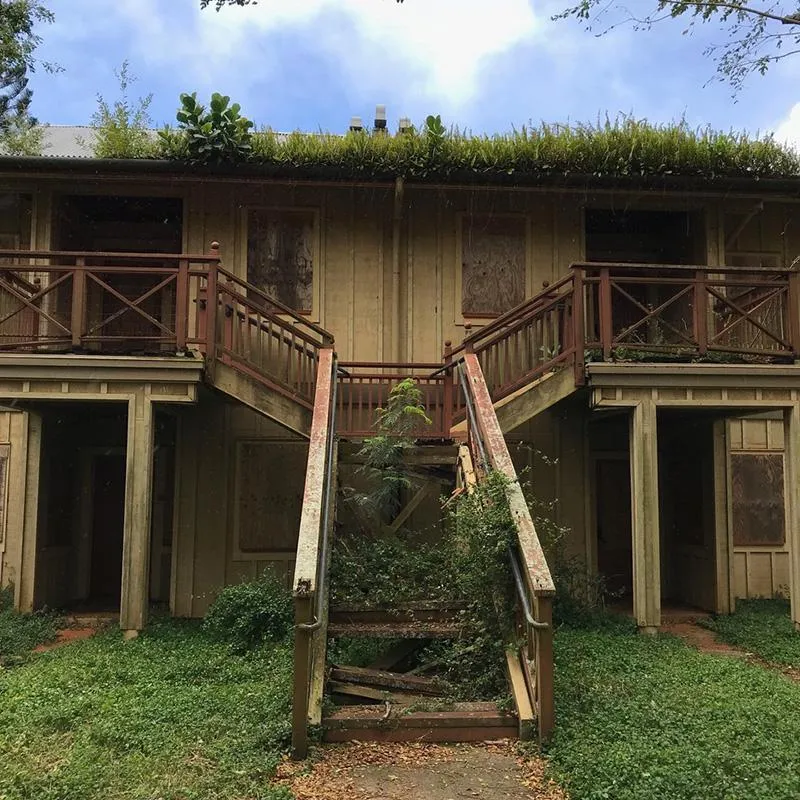Why Molokai, With All Its Wonders, Is the Least Developed of Hawai‘i’s Islands
Even centuries before Captain Cook’s arrival, its resources were exploited by outsiders
/https://tf-cmsv2-smithsonianmag-media.s3.amazonaws.com/filer/56/39/5639f184-c8c5-4707-bf3d-b480e91c61c6/protest-cruise-ship-no-process-650x433_lead.jpeg)
The first thing that strikes a visitor to the Hawaiian island of Molokai is how empty it is. From the approach of the propeller-driven airplane that brings you from bustling Oʻahu or Maui, you see mile after mile of beaches with no sign of people, and square mile after mile of scrubland marked by nothing more than occasional red dirt roads. It seems a throwback to an older, simpler Hawai‘i, before mass tourism, high-rise hotels, crowded beaches, and traffic gridlock.
On Molokai, there is not a single traffic light, and the only things that might be called traffic are a few pickup trucks waiting for a parking spot along the three-block-long main street of the island’s single sizable town, Kaunakakai, population roughly 3,000. Somewhat more than 7,000 people live on the island—about 0.5 percent of the state of Hawai‘i’s population of 1.4 million. There is just one hotel, and only a handful of restaurants more ambitious than burger shacks, spread over the island’s 38-mile length.
In often rushed and congested contemporary Hawai‘i, such a place seems nothing short of miraculous. But that emptiness also signals an extraordinarily deep malaise: For generations, Molokai has proven stubbornly resistant to broad-based economic development, as well as the stability that comes with it. Available work has generally been in low-level agricultural jobs for outside corporations running plantations here, subject to the fickle winds of the global economy—or for government, itself directed from off-island, as Molokai is a part of much larger Maui County (population 166,000).

Average incomes have long been well under the statewide figures, and unemployment numbers have often nearly doubled the statewide rate. Nearly a third of families use food stamps—twice the rate on Maui and triple that on Oʻahu. Because of its unusual level of welfare dependency, the island was one of a handful of U.S. communities granted exemptions to welfare reform laws during the Clinton administration. With few exceptions, young people looking for more than minimal prospects must leave for other islands or to the U.S. mainland.
Locally generated, smaller-scale, diverse businesses have long struggled. As Hawai‘i as a whole responded to the postwar demise of its sugar industry by shifting to tourism, Molokai was slow to follow suit, and faltered in the face of recessions, mismanagement by foreign owners, and determined local opposition. Now, everywhere you look, businesses are shuttered, storefronts empty.
On the West End, a golf course spectacularly sited above the ocean lies overgrown and abandoned, its once-expensive landscaping of coconut palms now leafless and dead from lack of irrigation. Former hotels and condominiums sit boarded up and rotting, their wooden staircases collapsing and disappearing beneath billows of vines. The only movie theater closed more than a decade ago.
There are pockets of comparative underdevelopment on all of the Hawaiian islands, but only Molokai is marked by a long-term, persistent failure to develop in step with its neighbors. This failure is more remarkable for its longevity. The pattern extends not only back through the 18th and 19th centuries, when the Hawaiian Islands—the most isolated major landmass on Earth—opened to the wider world, but reaches centuries further back into pre-contact, Polynesian Hawai‘i, when the island was similarly marginal to the larger islands of the archipelago. It is a very long durée of marginality.
Why is Molokai different? The answers lie both in the peculiarities of Hawai‘i, and in the nature of marginal places generally.
For most Hawai‘i residents, Molokai defines what is called “outer island” Hawai‘i—peripheral and rarely visited. For most of the world, it connotes remoteness. Its mere name conjures visions of the tragic leper colony founded in 1866 on the inaccessible Kalaupapa Peninsula, a place chosen for its isolation as a quarantine site for the thousands of people, most of them Native Hawaiians with little immunity to the disease, who were torn from their families and exiled there to die.
Yet Molokai isn’t remote. It sits dead center of the main Hawaiian chain, only 25 miles from Oʻahu, with its population of nearly 1 million, and just 8.5 miles from bustling Maui. On most days it is visible from both, as well as from Lanaʻi, and, on a clear day, even the Big Island of Hawaiʻi. On most nights, the bright lights of the capital city Honolulu stain Molokai’s sky yellow to the west, while those of Maui’s Kaʻanapali coast do so to the east. Nor is it especially small: 38 miles long and 10 miles wide at its widest point, it is the fifth largest of Hawai‘i’s islands. It is nearly twice the size of neighboring Lanaʻi, with more than double the population, but shares with it many characteristics, including having long been mostly controlled by outsiders. Nearly 85 percent of Molokai is controlled by seven owners, all but one of them headquartered off-island.
Molokai boasts the longest fringing coral reef and the longest white sand beach in the state, and the tallest sea cliffs in the world. It has all of the things the other islands have that can be turned to profit: well-watered valleys good for traditional Polynesian agriculture, flat land suitable for modern farming, shorelines protected from waves (in the Polynesian period, the south shore sheltered 50 or more fishponds, the largest aquaculture complex in the Pacific), and all the lovely beaches, swaying palms, towering waterfalls, and rainforests to attract tourists.
Molokai’s trouble is that it has fewer of these attractive things than its larger neighbors—and many more unprofitable features. Much of the island is inhospitable. The entire north coast is girded by plunging cliffs and pounded by giant ocean swells. Most of the eastern half is made up of steep mountains and deep canyons. And most of the western half is typically dry. The entire island is raked by stiff trade winds. The places of abundance are, relative to its neighbors, few and small. It is this relative lack of resources that forms the backdrop to understanding Molokai’s history and its present.
In the Polynesian period, Molokai, close at hand and weaker than neighboring islands, beckoned powerful outsiders to conquer and exploit, often en route to larger battles elsewhere. For centuries, all the way up to King Kamehameha I in the early 1800s, Hawaiian armies moving between Oʻahu, Maui, and Hawaiʻi, stopped and fought over the island, often laying it waste. The island was known as a place easy to subjugate, but because so much of its land area is inaccessible—steep upland forests, sheer sea cliffs girding wave-blasted, rocky coastlines where small, dispersed communities held out—it’s proven difficult to fully subdue and rule from outside.
These smaller populations and places cultivated a reputation for strong spiritual practices used to resist outsiders. One was famed for a type of poison trees, kalaipahoa; another for its anti-chief sorcery. Indeed, the island was called O Molokai i ka pule oʻo, “Molokai of the powerful prayer,” a place of sorcery and poisons used against outsiders, and misty, remote places of refuge beyond their grasp. (Kamehameha’s invaders were said to have been killed en masse by pule oʻo—though at least one local informant insisted that the warriors were not prayed to death but were fed sweet potatoes mixed with ‘auhuhu, a common fish poison.)

Where outside chiefs did achieve control, they bent the people and the land to producing a surplus, mostly of kalo (taro) and hogs, for their own aggrandizement—a process anthropologists call agricultural “intensification.” In a landscape where water is as unevenly distributed as Hawai‘i, the key to this intensification was control of water, used for the irrigation systems that underlie Polynesian farming. With it came control of land, of people, of wealth, and of the very structure of society. As all over Polynesia, what developed in these fertile places was a pyramid, with a hereditary aristocracy ruling, through its monopoly control of water, over a highly class-stratified society.
And, as happened elsewhere in Hawai‘i and in Polynesia, agricultural intensification had serious environmental side effects. Expanding irrigation systems farther up watersheds into steeper, more erodible topography was achieved by the felling and burning of forests to clear land, all of which increased erosion, thereby damaging soils. The effects were cascading. Increasing portions of an already fragile landscape were deforested, eroded, and desiccated by Polynesian Hawaiians over the centuries after their arrival in the islands, roughly 1,000 years ago.
Though seemingly paradoxical, environmental degradation was “good” for those at the top of the social pyramid. First, it directly converted complex natural ecosystems into simplified factories for surplus production. Second, degraded landscapes stressed or destroyed the subsistence communities that had thrived outside of the fertile areas, forcing more people into the system of monopoly control by ruling chiefs.
These patterns on Molokai were continued, and amplified, after contact with the outside world, beginning with Captain Cook’s arrival in 1778. Investors and speculators, including newly dollar-minded Hawaiian kings from Oʻahu, came to Molokai to squeeze a profit out of it. Sugar growing, which dominated Hawai‘i for 100 years, was attempted at several scales, but failed for lack of sufficient water. Pineapple, well-matched to the climate, was successfully grown by two outside corporations, Dole Food Company and Del Monte Foods, for much of the 20th century, until competition from larger, lower-wage competitors in Latin America and Asia drove Molokai out of the business.
One business did succeed, seemingly paradoxically, because of environmental limitations: livestock grazing. A perverse law of resource development states that even badly degraded land, if there is enough of it, can support big operations, if the right commodity can be produced in sufficient quantities. The scale of the effort then abets itself, setting up a destructive feedback loop. Soon after cattle, sheep, and goats were introduced to Molokai in the 19th century, they quickly helped to destroy what was left of the native flora, leaving much of island nearly barren but for alien, introduced grasses—therefore useable only for more grazing.
Outsiders bought larger and larger pieces of land, many of the parcels purchased cheap from Native Hawaiians who lacked cash and investment capital for the enterprise. More intensive grazing in turn drove more degradation—more deforestation, desiccation, and erosion. Traditional subsistence options were disrupted. Springs dried up, fishponds filled in with mud washed down from the uplands, reefs were likewise smothered, and communities were forced to retreat or breakup, their members scattered to work in the wage economy elsewhere.

One terrible example was the coastal hamlet of Palaʻau, whose people had once done well with fishponds, fishing, and farming. Then grazing animals owned by a large ranch on the West End chewed up the surrounding landscape. Eroded silt covered their spring, ponds, and reef flats. This actually pushed the shoreline a quarter mile out to sea. The people of Palaʻau, with little left to exploit, were accused of cattle rustling. And soon the entire town was arrested and packed off to Honolulu, where its people were forced to build the prison in which they would be incarcerated. Today the site is an empty scene of tangled thorn trees and gullied dirt roads, with no sign anywhere of its former inhabitants or their works.
In the 20th century, cattle ranching dominated the West End and the far East End, while two large, vertically integrated pineapple plantations laid claim to much of the center of the island. Both sectors were intensive and extensive, monoculture producers of cash commodities for export, with the profits expatriated to outside owners. All were racially stratified, with a small number of white owners and managers supervising a nonwhite workforce.
Maunaloa on the West End, for five decades the headquarters of a large, California-owned plantation, was laid out according to a strict racial hierarchy. Filipino town, for the field workers, with wooden dormitories, lay at the lowest point on the slope. Japanese town, for the lunas, or field bosses, with wooden, shared houses, was adjacent and slightly uphill. “The Hill,” for the whites, had American-style, concrete-block houses complete with plumbing and electricity. All of these enterprises were outside-owned and reliant on near-monopoly control of water and land. All were possible due to previous environmental degradation, and all caused more of it, especially erosion, with the added heavy use of chemicals such as fertilizers, herbicides, pesticides, and fungicides. Residues of these substances still linger in the soil, posing a challenge to those now attempting to make a go of small farming on the island.
Molokai has long served as a literal and figurative quarry for outside economic interests. Sand was exported from the West End, starting in 1962, from Kanalukaha Beach, near Hale o Lono Harbor, and from Papohaku Beach, to build up the lucrative tourist strands in Waikiki, Honolulu, and in Santa Monica, California. The sand mining operation was outlawed by the state legislature in 1975, but its legacy of diminished beaches at those two sites remains a stark reminder of the destructive logic of the exploitation of marginal places.
The Mediterranean historian Fernand Braudel wrote that, in the development of the world economy, foreign demands impose “an intrusive monoculture, destructive of local balance.” Molokai’s story, while expressive of this rule, also adds a cultural dimension that amplifies the trajectory of outside domination.
The adversarial relations between small, dispersed subsistence communities and larger outside forces seen in the Polynesian era were repeated in the modern era, taking the form of livestock poisonings, arson, and even one murder, when a Molokai Ranch manager was blown up in his car in 1923.

In recent decades, this dynamic has continued, as a small but vocal group of Molokai residents has aggressively opposed plans for economic development, protesting and successfully blocking proposals for hotels, condominiums, golf courses, cruise ship visits, inter-island ferry service, and wind energy (the notably windy island remains powered by expensive, imported diesel generation). A long and bitter standoff over proposed residential development between activists and the island’s largest landowner and employer, Molokai Ranch, resulted in the closure of all the ranch’s operations in 2008 and the loss of 120 jobs. So fragile is Molokai’s economy that the unemployment rate jumped from 6.2 percent in 2007 to 13.7 percent in 2009 as a result.
Recent attempts to ban genetically modified crops have put the island’s current largest employers, Monsanto and Mycogen Seends, in the crosshairs. Both companies test GMO seed corn there, in an uncanny echo of Molokai’s former vocation as a site of quarantine. If the companies go, they will take another 240 jobs—roughly 10 percent of the island’s workforce—with them. As with the Molokai Ranch closure, the cascade effects on small, local businesses would be extreme.
The character of the opposition is notable: While the activists as a loose group are not without diversity, the core members are people of Native Hawaiian descent. Their commitments, tactics and goals are rooted in the Hawaiian Renaissance movement of the 1970s, which revived traditional Hawaiian culture, language and ritual, and demanded recognition of sovereignty for Native Hawaiian people.
In Molokai, local activists used federal and state laws protecting archaeological remains to block, slow, or minimize development and to assert the rights of contemporary Hawaiians to hunt, fish, and gather on private lands. They were also successful in stopping sand mining on the West End, and, ultimately, the U.S. Navy’s bombing of tiny Kahoʻolawe island, off of Maui.
For many in Molokai, subsistence strategies such as fishing, hunting (mostly non-native axis deer), and small-scale farming have become economically essential. Furthermore, these strategies have come to represent Hawaiianness. The desire to preserve culture has taken on a posture of resistance to the market economy in general and to specific proposals of economic “development,” even if they might benefit the community.
The divisive climate on the island is palpable, and visible. On leaving the airport, visitors see a hand-painted sign: “Visit, Spend, Go Home.” It has had an undeniable effect. The number of visitors to “the friendly isle,” as tourism promoters once dubbed it, slid from 103,477 in 1990 to 59,132 in 2014—a decline of 43 percent. Even the Kalaupapa mule ride, an iconic tourist stop, has closed.
History is still too often explained by looking at powerful, central, dominant places. Yet most of the world is not a center, but a margin—by definition the periphery is larger and more extensive than the core. Molokai, Hawaii shows how such places can become caught in cycles of degradation, exploitation, and marginalization. In this unfortunate context, Molokai is at once exceptional, and typical.
Wade Graham teaches urban and environmental policy at the School of Public Policy at Pepperdine University. His most recent book is Braided Waters: Environment and Society in Molokai, Hawaii.
Planning Your Next Trip?
Explore great travel deals
Smithsonian magazine participates in affiliate link advertising programs. If you purchase an item through these links, we receive a commission.